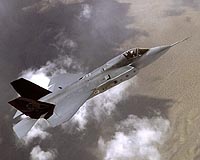| . |  |
. |
Farnborough UK (SPX) Nov 04, 2009 BAE Systems will submit its bid for the British Army's most important programme on Thursday 5 November. The bid is for "Recce Block 1", the GBP2 Bn first phase of the FRES SV (Future Rapid Effect System - Specialist Vehicles) programme. The Scout variant will give British troops a much-needed replacement for the ageing CVR(T) Scimitar, with greatly improved protection, firepower and reconnaissance abilities. The UK Ministry of Defence has said it will select a winner in the first quarter of 2010. The BAE Systems contender for all the variants is based on the latest version of its proven CV90 chassis, sold to six countries and recognised as the best combat vehicle in its class. For the vital Scout role, the chassis has been shortened and given a lower profile. The company plans to minimise costs, meet the tight delivery schedule and align with the UK Armoured Fighting Vehicles (AFV) Strategy published in June by using a low-risk manufacturing approach proven with all five CV90 export customers. "We will use a tried and tested model to ensure the UK MoD has access to the information it needs to ensure operational sovereignty," says campaign director Arne Berglund. The chassis will be built at the company's existing production line at Ornskoldsvik in Sweden. The Scout turret and UK mission fit of all variants will be integrated onto the chassis in the UK, preserving jobs and the key skills necessary to continue to support British Army operations. BAE Systems has delivered well over 100 urgent operational requirements to modify vehicles in Iraq and Afghanistan, mostly to provide protection to crews against ever-changing threats. The CV90 chassis has a mature supply chain, much of it already in the UK, and BAE Systems plans to increase UK content. The vehicle, turret technology and weapon system all have significant export potential. Global Combat Systems managing director David Allott commented: "We are reshaping our business in line with the Armoured Fighting Vehicles Strategy. We are cutting costs, building our systems engineering skills and creating a more agile organisation to deliver FRES and Warrior upgrade. Our aim is to ensure a healthy, sustainable business which can continue to support UK land forces in training and on military operations." The BAE Systems candidate vehicle takes advantage of the best technology available today. "With each new customer, the vehicle has made a significant evolution to meet the changing face of warfare," says Berglund. "For instance, despite its relative light weight, our FRES candidate has mine protection comparable with main battle tanks weighing nearly twice as much. It has considerable growth potential, both physically and through its advanced electronic architecture." The open electronic architecture - essentially the vehicle's 'operating system' -will allow 'plug and play' upgrades to electronic systems, improve battlefield communications and have training and logistics benefits, particularly if it is rolled out across the Army's vehicle fleet. BAE Systems has already spent more than pound25m - not including the weapon system - on developing an all-new British-designed turret for the Scout variant. It features sophisticated sensor systems and a revolutionary 40mm cannon. The latter's ease of use, ability to fire on the move, versatility and much-increased punch means that it will give a major improvement over the 30mm Rarden gun used in Scimitar. Its 40mm high explosive round has more than three times the explosive power of the 30mm Rarden, while its armour-piercing projectile will penetrate more than 140mm of steel armour. The BAE Systems FRES demonstrator vehicle has already begun mobility trials at Millbrook proving ground and fired its weapon system at the Shoeburyness range. Its turret incorporates learning from two earlier designs. Share This Article With Planet Earth
Related Links BAE Systems The latest in Military Technology for the 21st century at SpaceWar.com
 F-35 looks to be costlier than planned
F-35 looks to be costlier than plannedLondon (UPI) Nov 4, 2009 Several adjustments related to the F-35 Joint Strike Fighter program could make the plane more expensive for European buyers. Rolls-Royce and General Electric earlier this week announced they would make adjustments to an alternate engine for the Lockheed Martin fighter plane, possibly resulting in additional development costs. The companies decided to redesign the engine after ... read more |
|
| The content herein, unless otherwise known to be public domain, are Copyright 1995-2009 - SpaceDaily. AFP and UPI Wire Stories are copyright Agence France-Presse and United Press International. ESA Portal Reports are copyright European Space Agency. All NASA sourced material is public domain. Additional copyrights may apply in whole or part to other bona fide parties. Advertising does not imply endorsement,agreement or approval of any opinions, statements or information provided by SpaceDaily on any Web page published or hosted by SpaceDaily. Privacy Statement |